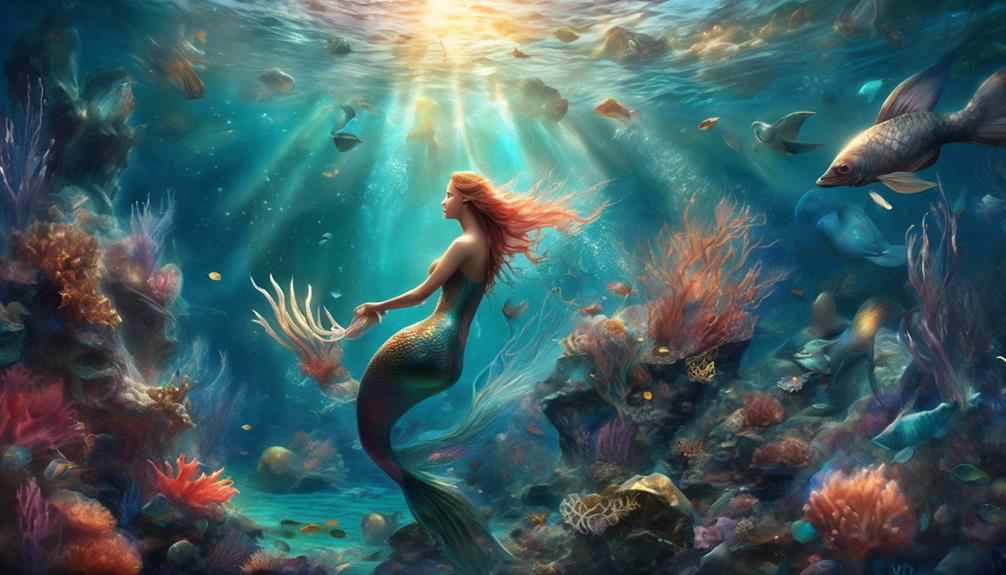The ocean has long been shrouded in mystery and myth, but what if some of these fabled tales could inspire real-world eco-friendly practices?
From ancient folklore to contemporary pop culture, there are numerous stories that offer insights into sustainable solutions for our oceans.
By tapping into these myths, a new wave of innovative and environmentally conscious practices has emerged, offering hope for the preservation of our planet's most precious resource.
These practices not only pay homage to ancient legends but also provide tangible ways to address modern environmental challenges.
Key Takeaways
- Seaweed wraps offer sustainable packaging solutions and help reduce reliance on single-use plastics.
- Implementing coral reef restoration projects is crucial for maintaining the balance of marine ecosystems and supporting biodiversity.
- Biodegradable mermaid tail costumes promote sustainable practices in the fashion industry and minimize harm to marine life and ecosystems.
- Promoting ocean cleanup with mythical creatures can inspire public participation and raise awareness about marine pollution.
Using Seaweed Wraps for Sustainable Packaging
Inspired by ancient maritime traditions, seaweed wraps offer a sustainable and innovative solution for eco-friendly packaging.
Seaweed farming plays a crucial role in the production of sustainable seaweed products. Through responsible cultivation practices, seaweed can be harvested without causing harm to the environment, making it an attractive option for eco-conscious consumers and businesses.
The process of seaweed farming also contributes to ocean health by absorbing carbon dioxide and providing habitat for marine life. Sustainable seaweed products, such as seaweed wraps, not only reduce the reliance on single-use plastics but also help in preserving the delicate balance of marine ecosystems.
Implementing Coral Reef Restoration Projects
The success of sustainable seaweed products has paved the way for a new endeavor: implementing coral reef restoration projects to further contribute to ocean health and biodiversity.
Coral reefs are crucial for marine biodiversity and play a significant role in supporting various marine species. By restoring coral reefs, not only can the habitats for countless marine organisms be preserved, but it also helps in maintaining the balance of marine ecosystems.
Additionally, healthy coral reefs are essential for sustainable tourism, as they attract visitors who contribute to local economies.
Implementing coral reef restoration projects is an action-oriented approach to address the declining health of these vital ecosystems. It's a passionate endeavor that requires collective efforts to ensure the long-term well-being of our oceans and the diverse marine life they support.
Embracing Biodegradable Mermaid Tail Costumes
Embracing biodegradable mermaid tail costumes promotes sustainable and eco-friendly practices within the ocean-inspired fashion industry.
Ocean-friendly fashion choices, such as biodegradable mermaid tail costumes, play a vital role in marine conservation efforts. These costumes are designed to break down naturally, reducing the environmental impact typically associated with traditional costume materials.
By choosing biodegradable options, individuals can express their love for the ocean while minimizing harm to marine life and ecosystems. Embracing these costumes encourages designers to innovate and create more sustainable fashion choices, fostering a community dedicated to protecting the oceans.
This shift towards eco-friendly costume options aligns with the growing global awareness of environmental issues. Together, through small but impactful choices like biodegradable mermaid tail costumes, we can make a difference in preserving our oceans for future generations.
Promoting Ocean Cleanup With Mythical Creatures
Promoting ocean cleanup with the help of mythical creatures continues the mission to protect marine ecosystems and foster sustainable practices in ocean-inspired activities.
Mythical creature conservation has become an innovative approach to promoting ocean cleanup initiatives. By incorporating mythical creatures from folklore and legends into ocean cleanup campaigns, organizations can capture the public's imagination and inspire greater participation. These creatures, often associated with the sea, can serve as powerful symbols for environmental stewardship, encouraging people to take an active role in preserving the oceans.
Initiatives that leverage mythical creatures in ocean cleanup efforts not only raise awareness about marine pollution but also create a sense of wonder and magic, making the endeavor more engaging and inspiring for people of all ages. By tapping into these mythical connections, ocean cleanup initiatives can reach new heights of impact and effectiveness.
Frequently Asked Questions
Are There Any Specific Regulations or Guidelines for Using Seaweed Wraps as Sustainable Packaging?
Regulations for using seaweed wraps as sustainable packaging depend on location. They may involve ensuring the seaweed is harvested sustainably, minimizing environmental impact. Organizations like the Marine Stewardship Council provide guidelines for eco-friendly practices in seaweed wrap production.
What Are the Biggest Challenges Faced When Implementing Coral Reef Restoration Projects?
Restoring coral reefs faces numerous challenges, including funding limitations, complex ecological interactions, and the impact of climate change. These obstacles require innovative solutions and collaboration to ensure the success of restoration projects and the future of coral reefs.
How Do Biodegradable Mermaid Tail Costumes Compare in Cost to Traditional Costumes?
Biodegradable mermaid tail costumes offer a cost-effective and environmentally friendly alternative to traditional costumes. Their production involves sustainable materials and creates less waste. The cost comparison favors biodegradable options, promoting eco-friendly practices.
What Are Some Unique Ways Mythical Creatures Are Being Used to Promote Ocean Cleanup Efforts?
Mythical creature conservation and ocean-themed art are inspiring eco-friendly tourism and sustainable seafood practices. They encourage innovative approaches to promote ocean cleanup efforts, highlighting the importance of preserving marine environments for future generations.
Are There Any Potential Downsides or Limitations to Embracing These Eco-Friendly Ocean Practices Inspired by Myth?
Embracing eco-friendly ocean practices inspired by myth can have potential drawbacks and limitations. While these strategies can raise awareness, they may not always be feasible or effective in every ocean cleanup scenario.

